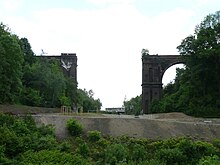Elias Railway
The Eliasbahn is a former works line of the Hörder Bergwerks- und Hütten-Verein in Dortmund 's Hörde district , which was built in 1890 to connect the blast furnaces on Phoenix-West with the Hermannshütte .
The name Fiery Elias , which is also widespread elsewhere, was particularly apt for this railway line, as the locomotive with its sparks also pulled wagons with molten pig iron.
Pig iron transport Phoenix-West – Phoenix-Ost
The Hörder Bergwerks- und Hütten-Verein had two production sites. On Phoenix-West, the pig iron was produced in blast furnaces. Further processing took place in the steel and rolling mills of Hermannshütte (Phoenix-Ost location). Both industrial sites were connected by a 1.6 km long works railway. The Eliasbahn route ran on a railway embankment with several bridges right through the Hörde district. Until the shutdown of the production facilities in 1998, liquid pig iron was transported in torpedo cars to the oxygen steelworks on Phoenix-East. To protect against accidents with the hot cargo, the tracks were laid in a trough made of reinforced concrete. At that time, the sky over Hörde often glowed red due to the transport of pig iron during the night. From the end of the 1960s, the transports were covered. Partly parallel to the Elias Railway, several pipes were used to transport the blast furnace and coke oven gas between the operating parts. The largest pipe had a diameter of 2 m and a wall thickness of 20 mm. There was a continuous pipeline between the Hansa coking plant in Huckarde, via the Phoenix-West and Phoenix-East steelworks, along the Eliasbahn in Hörde to the site of the former Westfalenhütte .
After the route of the Eliasbahn had not been used for a few years, it gained new importance as part of the renovation of the Phoenix locations. In 2006 the former railway line next to the trough structure was provided with an asphalt surface. From September 2006 onwards, trucks with the excavated soil from the Phoenix Lake, which is under construction, drove there without contact with public road traffic . By mid-2007 a total of 500,000 m³ of excavated material had been transported from the Phoenixsee to the Phoenix-West site.
The last remains of the trough structure were demolished in March 2008. A cycle and footpath runs along the Eliasbahn route as a direct connection between Lake Phoenix and Phoenix-West.
Further routes
A second runway existed on the premises of the Phoenix-West steelworks. This was used to transport slag from the Phoenix-West blast furnace to the dump at the Buschmühle . The bridgeheads of a viaduct have been preserved from this works railway.
As early as 1859, the “Hörder Verein” established a narrow-gauge connection from the Hermannshütte to its Schleswig colliery in Neuasseln . This line was converted to standard gauge in 1877 and continued to the Holstein colliery and Wickede-Asseln station on the Welver – Sterkrade railway line in 1885 . Ember slag from the Phoenix-West blast furnace was also deposited on the mining dump of the Schleswig colliery. The northern part of the heap served as a rubble dump from the post-war period until the scheduled closing of operations in 2007 . The tracks of the works railway have been dismantled, a railway bridge in Schüren that has been converted for a cycle path , an unused bridge in Neuasseln and long stretches of the railway embankment are still preserved.
literature
- Willi Garth, impressions from Hörde , Association for the Promotion of Home Care eV Hörde, 1999, extended new edition 2004 ( online )
Web links
- Final chapter Hörder Stahlgeschichte - WAZ on the demolition of the last section of the Elias railway line


